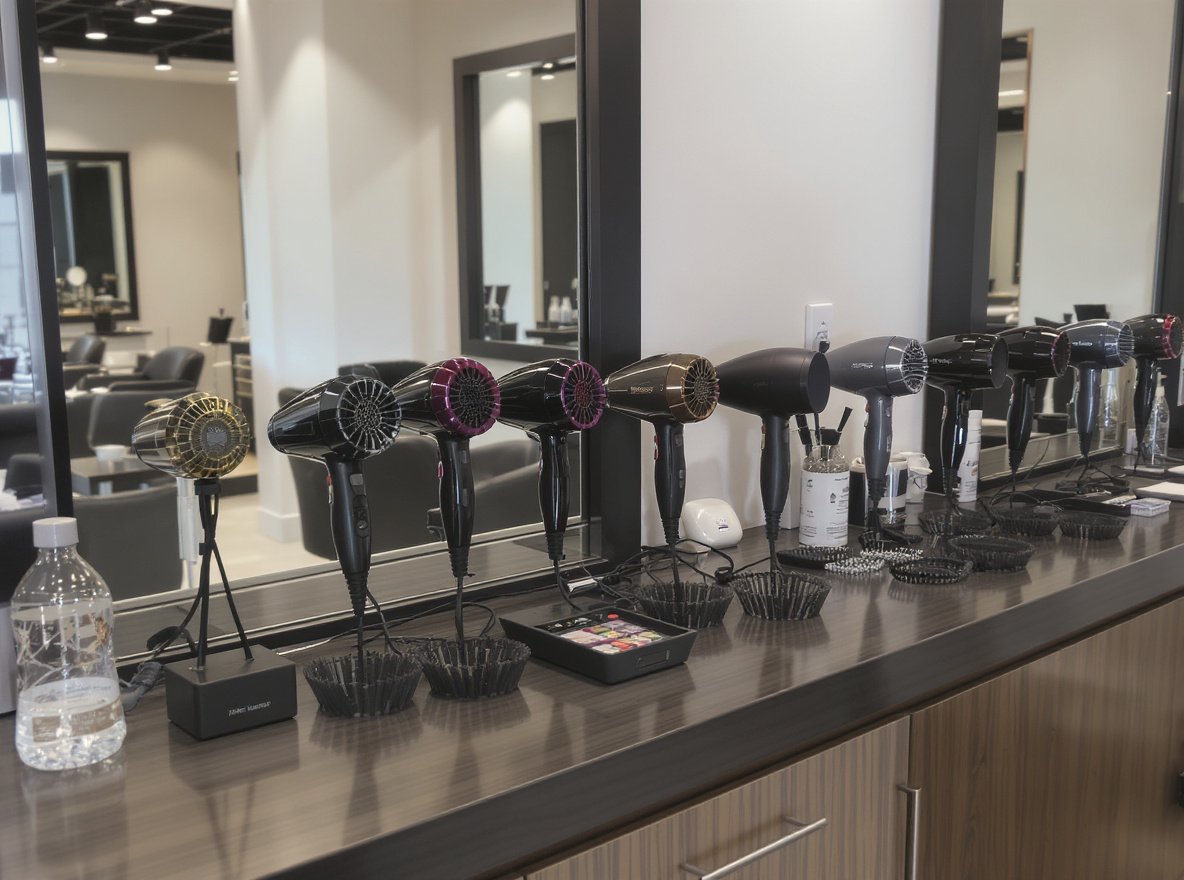PC maintenance is essential, but using the wrong tools can damage your expensive equipment. Many people wonder if they can use common household items like hair dryers for PC cleaning instead of buying specialized equipment.
No, you should never use a hair dryer to clean a PC. Hair dryers generate static electricity and heat that can permanently damage sensitive computer components like motherboards, RAM, and graphics cards. They also lack the focused, high-pressure airflow needed for effective dust removal from tight spaces within your computer.
Let’s explore the safe alternatives and proper PC cleaning methods that won’t put your equipment at risk.
Table of Contents
ToggleWhy Hair Dryers Are Dangerous for PC Cleaning
Using a hair dryer might seem like a logical solution for blowing dust out of your computer, but several factors make this approach extremely hazardous to your hardware.
Hair dryers create static electricity that can destroy electronic components instantly. They also generate heat and lack the proper air pressure needed for effective PC cleaning, making them completely unsuitable for computer maintenance.

The Static Electricity Problem
Hair dryers generate static electricity that poses serious risks to sensitive electronic components. Static discharge can damage or destroy critical parts like your motherboard, RAM, or GPU even when you can’t feel the shock yourself.
Unlike specialized PC cleaning tools, hair dryers are designed for hair care, not electronics maintenance. The electrical charge they build up is beneficial for hair styling but devastating for computer circuits that operate on precise electrical tolerances.
Insufficient Air Pressure Issues
Hair dryers don’t provide the focused, high-pressure airflow needed to dislodge dust from tight spaces within your PC. Their broad air pattern simply pushes dust around rather than removing it effectively.
Professional compressed air tools deliver concentrated bursts of air that can penetrate small crevices and thoroughly clean components. Hair dryers lack this precision and power, making them ineffective for proper dust removal.
Heat Generation Concerns
Even when using the “cool” setting, hair dryers can emit warm air that increases temperatures inside your PC. This additional heat can potentially damage components or cause condensation, creating moisture problems in your computer.
Computer components are designed to operate within specific temperature ranges. Introducing external heat from a hair dryer disrupts these carefully controlled thermal conditions and can cause immediate or long-term damage.
Contamination Risks
Hair dryers can blow small particles, fibers, or lint into your PC, introducing new contaminants instead of removing dust. These particles can accumulate on components and create additional cleaning challenges.
| Risk Factor | Hair Dryer Impact | Professional Tool Alternative |
|---|---|---|
| Static Electricity | High risk of component damage | ESD-safe compressed air |
| Air Pressure | Insufficient for effective cleaning | High-pressure focused airflow |
| Heat Generation | Potential overheating issues | Room temperature air output |
| Contamination | May introduce new particles | Clean, filtered air delivery |
What Are the Safe Alternatives to Hair Dryers?
Professional PC cleaning requires the right tools and techniques to protect your investment while maintaining optimal performance.
The safest and most effective method is using compressed air cans specifically designed for electronics, combined with anti-static cleaning tools and proper safety procedures.

Compressed Air Cans
Compressed air cans are the industry standard for PC cleaning. They deliver powerful, focused bursts of air to remove dust without direct contact with sensitive components.
These tools provide several advantages over hair dryers:
- Focused, high-pressure airflow for effective dust removal
- No static electricity generation
- Room temperature air output
- Precise directional control
Electric Air Dusters
For frequent cleaning or business use, electric air dusters offer a cost-effective long-term solution. These rechargeable tools provide similar airflow to compressed air cans but eliminate ongoing purchase costs.
Electric dusters are particularly valuable for businesses managing multiple computers. They deliver consistent performance and reduce operational expenses while maintaining the same safety standards as canned air.
Soft-Bristled Brushes
Use clean makeup brushes, paintbrushes, or toothbrushes to gently loosen dust from components and fans before using compressed air. These tools help prepare surfaces for more effective cleaning.
Choose brushes with soft bristles to avoid scratching delicate surfaces. Anti-static brushes are available for added protection against electrical discharge during cleaning.
Additional Cleaning Tools
- Microfiber cloths: Perfect for wiping down surfaces and screens without scratching
- Silicon air blowers: Useful for targeted dust removal in tight spaces
- Cotton swabs: Ideal for cleaning small crevices and detailed component areas
- Isopropyl alcohol: For stubborn residue removal when used with proper techniques
How Often Should You Clean Your PC?
Regular maintenance prevents dust buildup that can cause overheating, performance degradation, and component failure.
Clean your PC every 6-12 months for deep cleaning, with filter maintenance every 2-4 times per year. Adjust frequency based on your environment and usage patterns.

Standard Cleaning Schedule
Deep cleaning every 6 to 12 months is recommended for most users. This interval prevents significant dust accumulation while avoiding excessive handling of sensitive components.
Filter cleaning should occur 2 to 4 times annually, especially if your environment is dusty or you have pets. Clean filters maintain proper airflow and reduce internal dust buildup.
Environmental Factors
Your cleaning frequency should increase based on these conditions:
- Dusty environments or construction areas
- Pet ownership (hair and dander accumulation)
- Smoking in the home
- High computer usage intensity
- Poor case ventilation design
Performance Indicators
Monitor these signs that indicate more frequent cleaning may be necessary:
- Increased fan noise or unusual sounds
- Higher operating temperatures
- Visible dust buildup on external vents
- Reduced system performance
- Unexpected shutdowns or instability
Step-by-Step Safe PC Cleaning Process
Following proper procedures ensures effective cleaning without damaging your hardware investment.
Always shut down your computer completely, unplug all power cables, and wait 30 minutes before beginning any cleaning process.

Preparation Phase
Before starting, gather these essential items and prepare your workspace:
- Compressed air cans or electric air duster
- Anti-static wrist strap (optional but recommended)
- Soft-bristled brushes for loosening dust
- Microfiber cloths for surface cleaning
- Cotton swabs for detailed work
- Good lighting and well-ventilated workspace
Safety Procedures
Turn off your PC and unplug all power sources completely. This ensures your safety and prevents electrical damage during cleaning.
Wait at least 30 minutes after shutdown to allow components to cool. Move your computer to a well-ventilated area, preferably outside, to avoid spreading dust indoors.
Cleaning Process
Remove the side panel of your computer case using appropriate tools. Assess the dust buildup and identify areas requiring attention.
Use soft-bristled brushes to loosen dust on fans, heatsinks, and components before applying compressed air. This preparation step makes air cleaning more effective.
Apply compressed air using short bursts rather than continuous spray. Hold fans in place to prevent spinning, which can generate voltage and damage the motherboard.
Focus on these critical areas:
- CPU cooler and heatsink fins
- Graphics card fans and heatsinks
- Case fans (intake and exhaust)
- Power supply fan area
- RAM slots and expansion slots
Post-Cleaning Inspection
After cleaning, inspect all components for loose connections or damage. Use cotton swabs and isopropyl alcohol to remove stubborn residue from accessible areas.
Ensure all components are completely dry before reassembly. Replace the case panel and reconnect all cables securely.
Why Professional Tools Matter for B2B Clients
For businesses in the hair dryer wholesale industry, understanding proper equipment usage is crucial for maintaining customer trust and product quality.
Professional-grade tools ensure consistent performance, reduce downtime, and protect valuable hardware investments in business-critical environments.

Reliability and Consistency
Professional tools like anti-static vacuums, electric air dusters, and ESD-safe brushes provide reliable results across multiple cleaning sessions. Standardized cleaning protocols reduce maintenance time and prevent hardware failures.
Just as manufacturing high-quality hair dryers requires precision engineering, maintaining computer systems demands proper tools and procedures. The same attention to detail that goes into the Laifex P1C high-speed hair dryer applies to professional maintenance practices.
Compliance and Standards
Using proper tools helps meet IT maintenance standards and warranty requirements, crucial for enterprise clients. Professional cleaning equipment ensures compliance with manufacturer guidelines and industry best practices.
Businesses managing multiple computers need consistent, documented procedures. Professional tools provide the reliability and performance necessary for maintaining complex IT infrastructure.
Cost-Effectiveness
While professional tools require initial investment, they reduce long-term costs through:
- Extended hardware lifespan
- Reduced repair and replacement expenses
- Minimized downtime and productivity losses
- Consistent cleaning results
Common Mistakes to Avoid
Learning from others’ mistakes can save you expensive repairs and operational disruptions.
Never use household vacuums, hair dryers, or any device that generates static electricity near computer components. These tools can cause immediate and permanent damage.

Dangerous Practices to Avoid
Using household vacuums or hair dryers is the most common mistake. These devices generate static electricity and are not designed for delicate electronics maintenance.
Other risky practices include:
- Applying liquids directly to components
- Letting fans spin freely during cleaning
- Using wet cloths near electrical components
- Cleaning powered systems
- Touching circuit boards with bare hands
Professional Best Practices
Always use tools specifically designed for electronics cleaning. Follow manufacturer guidelines and established procedures for consistent results.
Document your cleaning schedule and maintain detailed records. This approach helps identify patterns and optimize maintenance intervals for different equipment types.
For businesses, establish training programs to ensure staff understand proper cleaning techniques. Consistent procedures reduce risk and improve overall maintenance quality.
The Business Impact of Proper Maintenance
Whether you’re maintaining computer systems for your hair dryer wholesale business or ensuring product quality in manufacturing, proper maintenance practices directly impact profitability and customer satisfaction.
Regular, proper maintenance reduces downtime, extends hardware lifespan, improves performance, and protects critical business data.

Operational Benefits
Proper PC maintenance delivers measurable business benefits:
- Reduced system downtime and associated productivity losses
- Extended hardware lifespan, reducing replacement costs
- Maintained optimal performance levels
- Lower energy consumption from efficient operation
- Reduced risk of data loss and recovery costs
Quality Standards
Understanding the importance of using correct tools and procedures applies across all business operations. Just as computers require specialized cleaning tools, hair dryer manufacturing requires precision components and quality control measures.
The Laifex P1C exemplifies this commitment to quality engineering. Our high-speed hair dryer features advanced motor technology and durable construction that delivers consistent professional results, demonstrating the same attention to detail needed for proper equipment maintenance.
Long-Term Value
Investing in proper maintenance tools and procedures protects your technology investments. Clean systems run cooler, last longer, and maintain peak performance throughout their operational life.
For businesses in the hair dryer wholesale industry, this principle applies to both your internal operations and the products you offer customers. Quality equipment requires quality maintenance practices.
Summary
Hair dryers should never be used for PC cleaning due to static electricity risks, insufficient air pressure, and potential heat damage that can permanently harm expensive computer components. Instead, use compressed air cans, electric air dusters, and anti-static tools with proper procedures. Regular cleaning every 6-12 months prevents dust buildup and extends component life, protecting your technology investment and ensuring optimal performance.
Ready to explore professional-grade equipment that demonstrates proper engineering and quality control? Browse our complete range of high-speed hair dryers including the flagship P1C model at https://laifex.com/p1c-hair-dryer/ and contact us for wholesale pricing and partnership opportunities. Our team understands the importance of reliable, well-designed equipment for your business success.



